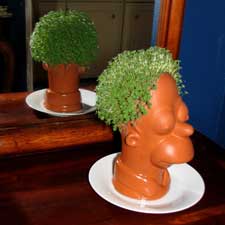Resource Library
Plant of the Week: Chia Pet
The University of Arkansas System Division of Agriculture does not promote, support or recommend plants featured in "Plant of the Week." Please consult your local Extension office for plants suitable for your region.
Plant of the Week
Chia Pet
Latin: Salvia columbariae

Every plant has a story to tell, but the most intriguing are those resonating in contemporary society. Cheesy, seemingly unexplainable fads such as ch-ch-ch-chia, the clay figurines we all know and love from the TV commercials, fits this description.
One would hardly suspect the Chia Pet® sprouting a green crown of seedlings on the windowsill represents a juncture between the customs of indigenous tribes and 20th century marketing savvy.
The aboriginal name "chia" is used interchangeably for three closely related species in the sage family; Salvia hispanica is found primarily in Mexico and Central America while S. columbariae grows in the desert southwest of this country. Chia Pets sport a mop of the latter species while most of the dietary supplement hype found on the Internet revolves around Salvia hispanica.
In its native haunts, Salvia columbariae is a fast growing annual making its growth in the moist period between February and May, then browning away as the heat of the desert summer arrives. It produces a basal rosette of wrinkled, gray-green, deeply divided leaves growing from 2 to 6 inches long.
The blue flowers are short lived but are borne in a purplish calyx that persists and extends the aesthetic appeal.
Chia Pets don't really fit the definition of a fad, because they keep reappearing like the cat that kept coming back in the children's song. This is the 25th anniversary of the Chia Pet concept, and it shows no sign of fading into history like its one-shot forbearer, the Pet Rock craze of 1975.
Chia Pets are the creation of Joseph Pedott, a San Francisco-based marketing guru and his firm Joseph Enterprises, Inc., who gave us such needed gadgetry as the Smart Clapper® to turn our lamps on and off. The Chia Ram appeared in 1982 and has been followed by about three dozen others that appear on shelves during the holiday season. While the name is trademarked the concept of clay figurines is not patented.
According to a company spokesman, the idea of marketing the product came from figurines traditionally produced in Mexico. Selling in the $20-dollar range, Chia Pets have found a niche for those compelled to give a gift but short on both money and ideas.
Chia was, according to Jesuit priests, the third most important food crop of the Aztecs prior to the Conquest. Its use as a food and dietary supplement has been rediscovered and chia is now being promoted as an aid in dieting, a slowly available energy source for runners, as a poultice for cuts and abrasions, and as the richest plant source for the heart-helping omega-3 fatty acids. Traditional medicines in Asia and the Americas both use a root extracts of this or a closely related species to "raise people from the dead," apparently by dissolving clots of stroke victims.
The mucilaginous nature of hydrated chia seeds make it useful both as a dietary supplement and for sticking to the grooves of a Chia Pet.
The hemicellulose fibers making up the outer layer of the seed is a naturally example of the "super slurper" products used in baby diapers and as soil amendments to keep the soil from drying out. They're extremely hydrophilic, absorbing up to 300 times their own weight in water and expand considerably in volume when wetted.
Chia seeds are first soaked in water and then slathered into the grooves of the porous clay figurines. Germination occurs in about five days when the head is positioned in a sunny window. The seedlings remain attractive for two weeks or so but eventually decline and die for want of nutrition. The seedlings are edible and some use them like alfalfa sprouts on salads.
I've not tried this in the garden but will try it in the sand bed I'm building in the rock garden.
By: Gerald Klingaman, retired
Extension Horticulturist - Ornamentals
Extension News - March 2, 2007
The University of Arkansas System Division of Agriculture does not maintain lists of retail outlets where these plants can be purchased. Please check your local nursery or other retail outlets to ask about the availability of these plants for your growing area.